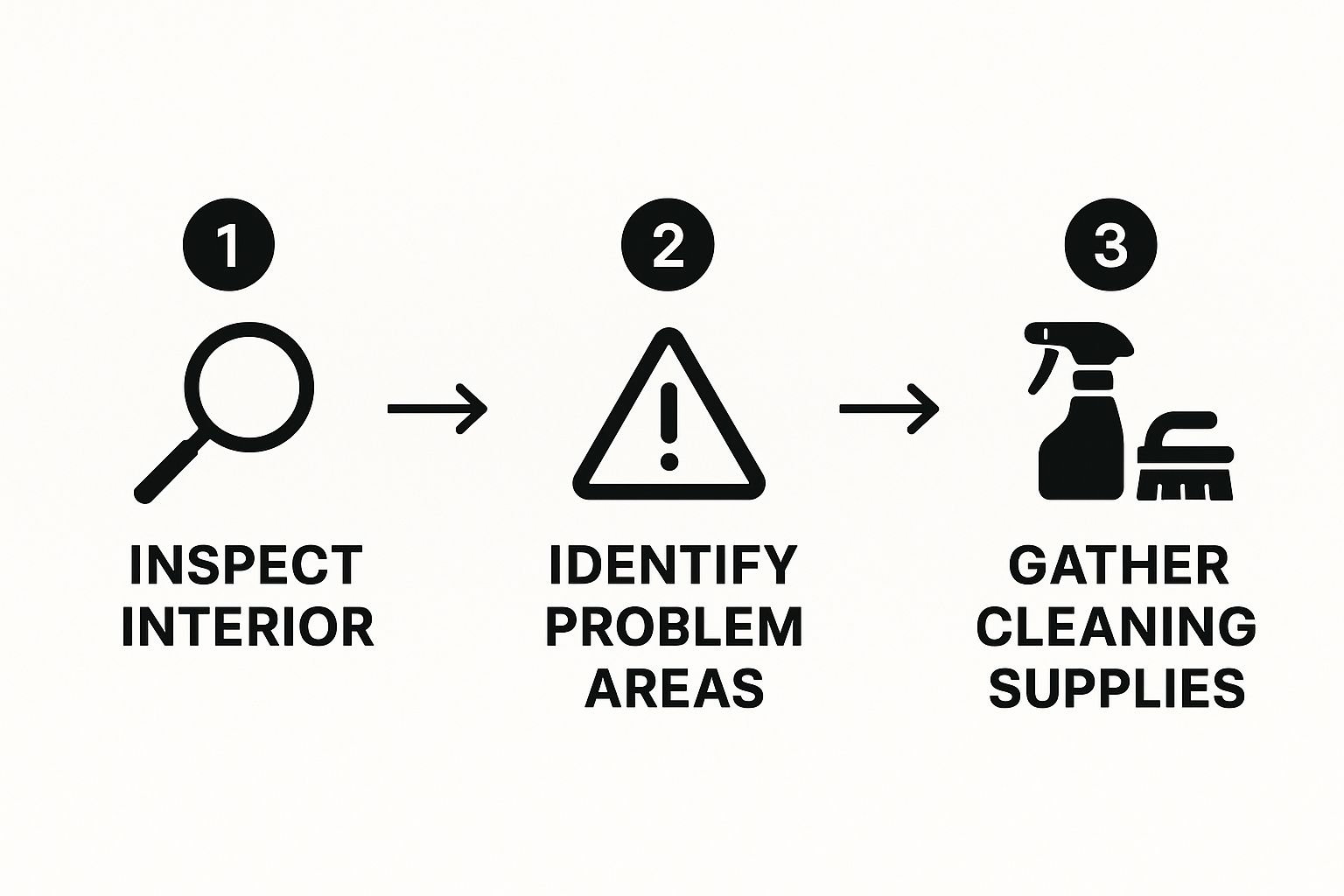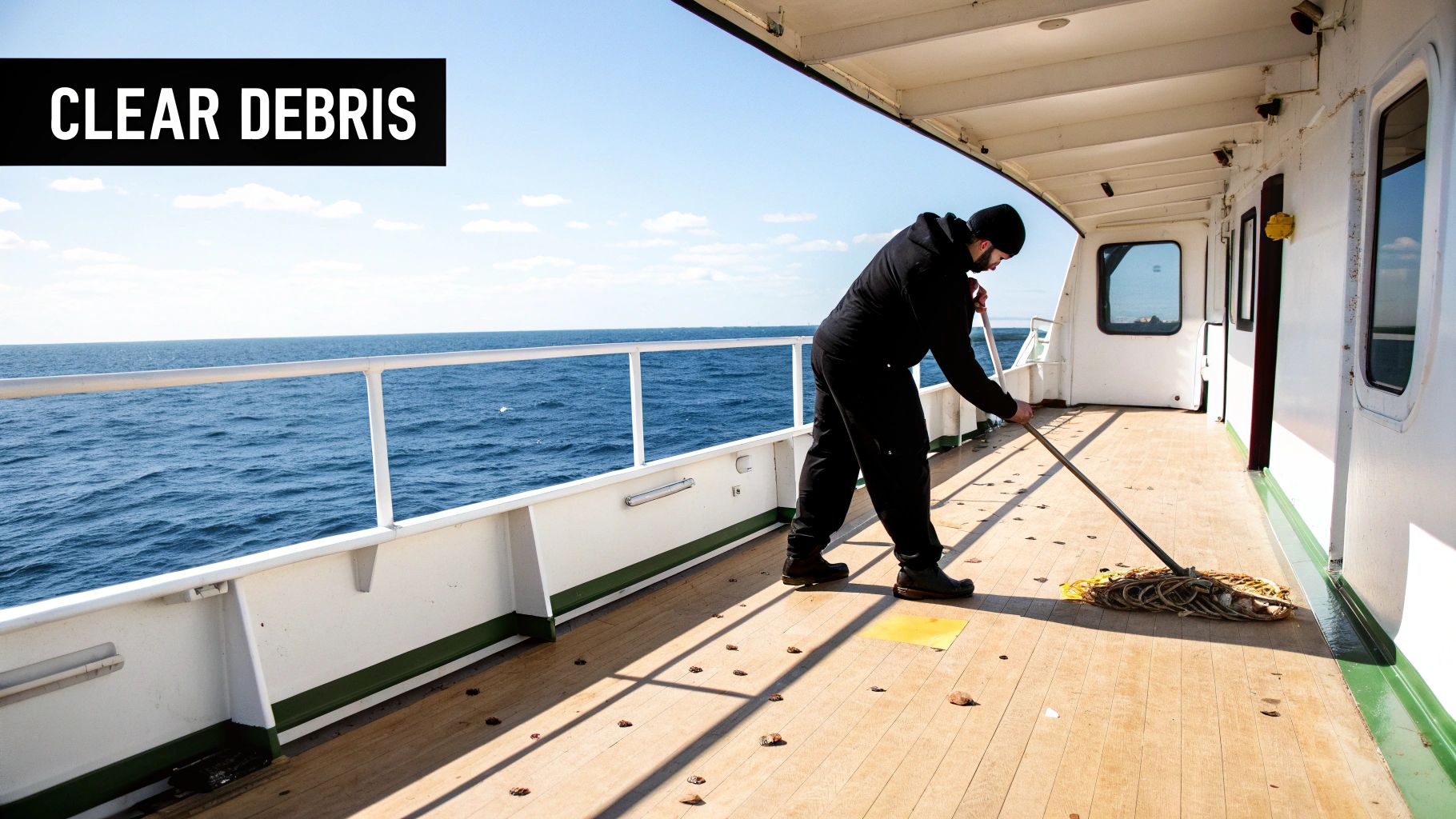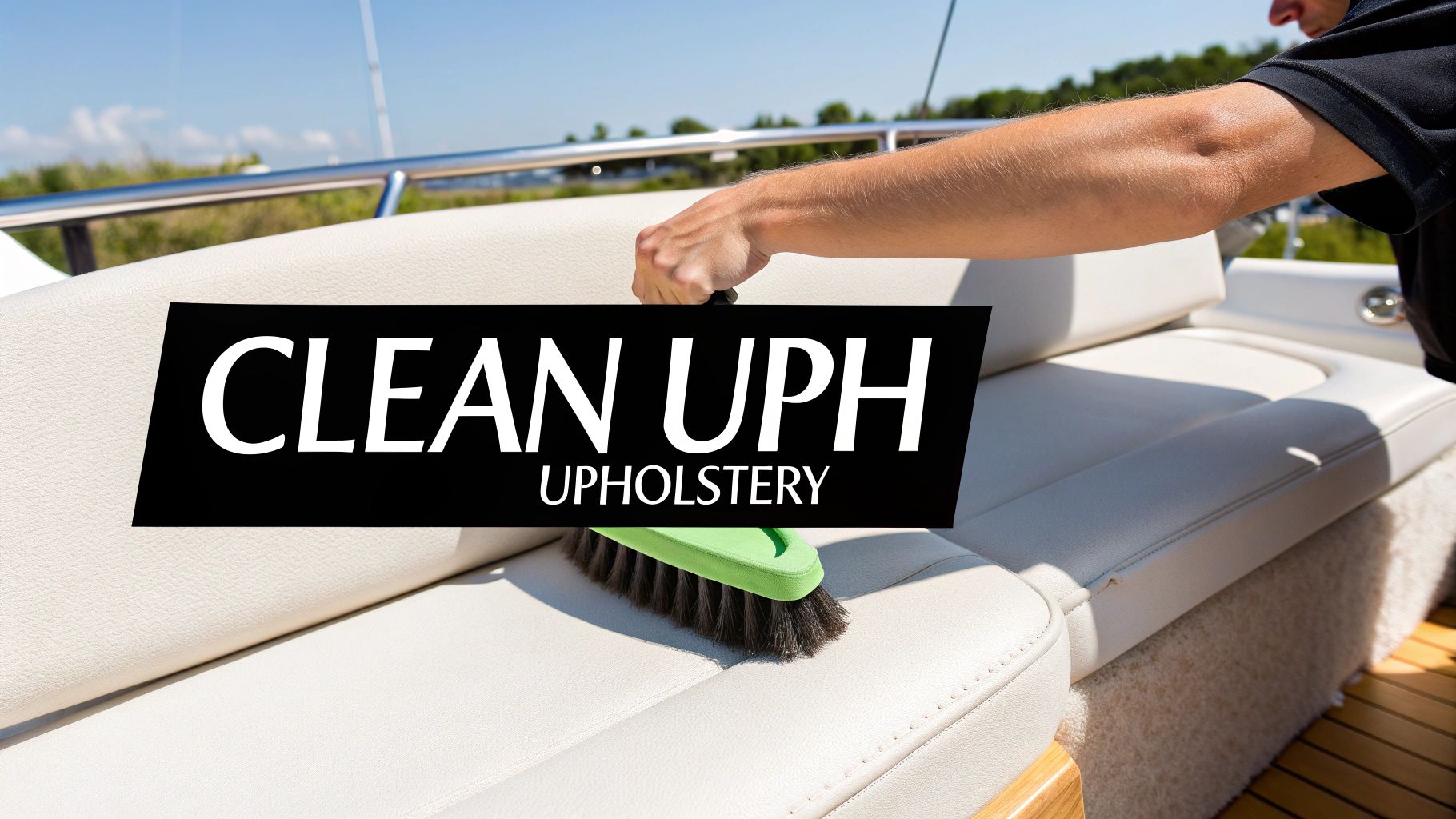How to Clean Boat Interior: Expert Tips & Tricks
If you want to get your boat’s interior looking truly sharp, you can’t just jump in with a sponge and hope for the best. I’ve seen it a hundred times—rushing the job is a surefire way to miss spots, use the wrong products, and end up with a finish that just doesn't feel clean. A little planning goes a long way.
Think of it like this: a well-thought-out plan is the difference between a frustrating weekend chore and a genuinely satisfying restoration project.
Your Game Plan for a Flawless Boat Interior
Before a single drop of cleaner touches a surface, the first and most critical step is to clear the decks—literally. Get everything out. Life vests, towels, fishing gear, stray water bottles, all of it. This isn't just tidying up; it's clearing the battlefield so you can see what you're really up against.
Once everything's out, grab a powerful shop vac with a good crevice tool. This is where the real work begins. You need to get into every nook, cranny, and storage locker to suck up all that hidden sand, dirt, and crumb buildup. You’ll be shocked at what’s been hiding in those tight spots.
Identify and Conquer
With a clean slate, you can finally do a proper walkthrough. Every boat is a unique mix of materials. You've got vinyl seats that need one type of care, marine-grade carpet that needs another, and maybe some fiberglass or wood trim in the galley that requires its own special touch.
Taking a moment to identify these different zones helps you gather the right arsenal of tools and products. This way, you’re not trying to use a one-size-fits-all approach that could damage sensitive surfaces.
This is the exact three-step process I follow to get a handle on any interior job before I start.

As you can see, a quick inspection isn't about wasting time. It’s about being smart, spotting problem areas early, and making sure you have the right supplies on hand from the get-go.
Plan Your Phases
To keep the project from feeling overwhelming, I always break it down into three simple phases: Preparation, Deep Cleaning, and Protection. This structure keeps you on track and makes sure you don't miss a single step.
It’s an approach that boaters are increasingly adopting. The global market for boat cleaners hit $3.16 billion in 2023, and it’s still growing. Why? Because owners are realizing that using specialized products in a methodical way is key to protecting their investment. You can see more on this trend over at Wise Guy Reports.
Here's a quick roadmap to help you visualize the process. It's a simple table, but it gives you a clear plan of attack before you dive into the nitty-gritty.
Your Boat Interior Cleaning Roadmap
| Phase | Key Actions | Goal |
|---|---|---|
| 1. Preparation | Declutter all loose items. Thoroughly vacuum every surface, crack, and crevice. | Create a clean, clear workspace to identify all areas needing attention. |
| 2. Deep Cleaning | Use targeted cleaners for vinyl, carpet, fiberglass, and other specific materials. | Remove all ground-in dirt, stains, mold, and mildew from every surface. |
| 3. Protection | Apply UV protectants to vinyl and plastic. Use fabric guards on upholstery and sealants where needed. | Shield your freshly cleaned surfaces from sun damage, moisture, and future stains. |
Following these phases turns a big job into a series of smaller, more manageable tasks. It's the secret to getting professional-level results every single time.
Building Your Ultimate Boat Cleaning Arsenal

Showing up to a messy boat with the wrong gear is like trying to paint a masterpiece with a toothbrush. It's frustrating, and the results will be disappointing, to say the least. Having the right tools isn't about spending a fortune; it's about working smarter, not harder. The goal is a pristine finish, and that all starts with what’s in your cleaning kit.
And this isn’t just a shopping list. Understanding why you need specific marine-grade products is the key to protecting your investment. Household cleaners are a major no-go. Their harsh chemicals can strip protective layers, dry out vinyl, and cause long-term damage that’s incredibly expensive to fix down the road.
Essential Cleaning Products
Your boat’s interior is a mix of specialized materials, and they’re all exposed to some pretty harsh conditions. You need products specifically formulated to handle that. A good starting point is a core group of cleaners designed for very specific jobs.
- Marine Vinyl Cleaner: Your seats take a beating from the sun, salt, and sunscreen residue. A dedicated vinyl cleaner, like our Better Boat Vinyl Cleaner, gently lifts grime without drying out the material, which is the first step in preventing ugly cracks.
- All-Purpose Cleaner: For general surfaces like fiberglass consoles, plastic trim, and tables, a pH-balanced, marine-safe all-purpose cleaner is invaluable. It quickly cuts through everyday dirt without leaving behind a harmful residue.
- Mildew Stain Remover: In the damp marine environment, mildew is an unwelcome but frequent visitor. A targeted mildew stain remover is essential for safely zapping these spots from upholstery and hard surfaces without bleaching or damaging them.
Must-Have Tools and Gear
Once you've got your cleaners picked out, the right tools will make the application effective and, more importantly, safe for your boat's surfaces. This is where you can really boost your efficiency and get that professional-level clean.
Pro Tip: I swear by the two-bucket method. Use one bucket with your soapy water solution and a second one with clean rinse water. After scrubbing a section, rinse your brush or cloth in the clean water bucket before dipping it back in the soap. This stops you from just smearing the dirt you just lifted right back onto the surface.
This simple technique makes a huge difference in the final result. It's a game-changer.
Next, let's talk about the physical tools you'll be using. Each one has a specific role to play in getting the job done right.
Your Go-To Tool Kit:
| Tool | Primary Use & Key Benefit |
|---|---|
| Microfiber Towels | Perfect for wiping and drying. Their fine fibers trap dirt and moisture effectively without scratching delicate surfaces like gauge clusters or polished wood. |
| Soft-Bristled Brushes | Ideal for agitating cleaners on textured vinyl or non-skid. The soft bristles work the product into grooves to lift embedded dirt without being abrasive. |
| Shop Vacuum | An absolute non-negotiable. Its powerful suction and attachments (especially a crevice tool) are critical for pulling up loose sand, crumbs, and debris from every corner before you start wet cleaning. |
Having this arsenal ready means you’re prepared for pretty much any mess you'll encounter. You can confidently move from sanitizing the galley to restoring the seats, knowing you have the perfect tool for every single task.
Bringing Vinyl Seats and Upholstery Back to Life

Your boat’s vinyl seats are often the star of the show, but man, do they take a beating. Between the constant sun, salt spray, and that awful sticky film from sunscreen, they can go from brilliant white to a dingy, sad state in no time. Getting them back to their former glory isn't just about a quick wipe-down; you need the right approach to clean them thoroughly without causing damage.
The secret is using a cleaner made specifically for marine vinyl. I always start by spraying a light, even coat of a quality vinyl cleaner onto a small section of the seat. Don't try to spray the whole bench at once—working in smaller, manageable areas ensures the cleaner won’t dry out before you’ve had a chance to work it in.
The Gentle Scrubbing Method
Once you've applied the cleaner, it's time for a little elbow grease. Grab a soft-bristled brush. And I mean soft. A stiff brush will scratch or even score the vinyl, and you can't undo that kind of damage. Using small, circular motions, work the cleaner into the material. You’ll see it start to foam up, lifting all that ground-in dirt and oil from the vinyl's texture.
This works wonders for everyday grime and even light mildew spots. If you’re facing a serious mildew problem, you might need to bring out a dedicated mildew stain remover, but for most jobs, the vinyl cleaner and soft brush combo is perfect. As soon as you're done scrubbing a section, wipe it clean with a dry microfiber towel to pull up all the lifted gunk.
It’s no surprise that specialized products are so crucial. The global boat vinyl cleaner market was valued at USD 150 million in 2024 and is projected to climb to USD 250 million by 2033. That tells you just how many boaters are realizing that proper care pays off.
Dealing with Sunscreen and Stains
Sunscreen is, without a doubt, one of the biggest culprits when it comes to ruining boat seats. Those oils and chemicals leave behind a sticky, yellowish film that acts like a magnet for dirt.
- For light residue, a single pass with your vinyl cleaner should do the trick.
- For a stubborn film, you might need a second application. This time, let the cleaner sit for a minute or two to really break down those oils before you start scrubbing.
- For deep stains like ink or dye transfer from a wet beach towel, you’ll need a more targeted approach.
A huge mistake I see people make is reaching for a magic eraser or an abrasive pad. Sure, they might lift the stain, but they'll also strip the vinyl's protective topcoat right off. That just leads to cracking and faster deterioration down the road. Stick with soft brushes and microfiber cloths—always.
For a deeper dive into handling these tough spots, check out our guide on how to clean boat seats. We cover everything from routine maintenance to rescuing seriously soiled upholstery.
The Final—and Most Crucial—Step: Protection
Cleaning is only half the job. Once your seats are sparkling clean and completely dry, you absolutely must apply a marine UV protectant. Trust me, this step is non-negotiable if you want your hard work to last.
Think of it as sunscreen for your vinyl. A good UV protectant creates a barrier that shields the material from the harsh sun that causes fading, drying, and cracking. Just spray it on, wipe it evenly across the surface with a clean microfiber cloth, and let it cure. This one simple step can easily double the life of your boat's upholstery.
Deep Cleaning Your Boat's Carpets and Floors

Let's be honest, boat carpets and non-skid floors are magnets for everything you bring aboard. Sand, dirt, spilled drinks, moisture, and odors all get trapped in these high-traffic areas. More often than not, this is where that funky "boat smell" comes from, so getting this part right is a game-changer when you're learning how to clean a boat interior.
Your first move should always be a thorough dry vacuuming. And I don't mean just a quick pass over the surface. Grab a crevice tool and get right into the edges where the carpet meets the cabin walls and under any furniture. This is crucial for pulling up the loose, abrasive grit that will turn into a muddy nightmare the moment you add a liquid cleaner.
The Wet Cleaning Process for Carpets
With all the loose debris gone, it's time for the deep clean. You absolutely must use a marine-safe carpet cleaner. I’ve seen people use household formulas, and it’s a mistake. They leave behind a soapy residue that actually attracts more dirt and can even break down the carpet's backing over time.
Before you go all-in, spot-treat any obvious stains. If you're dealing with stubborn smells—like that lingering fish odor or a musty scent from mildew—an enzymatic cleaner is your best bet. It literally breaks down the organic stuff causing the smell. Apply your main cleaner according to the directions, and gently work it in with a soft-bristled brush. You want to lift the grime, not fray the carpet fibers.
The biggest mistake I see boaters make is soaking their carpets. A damp approach is all you need. Drenching the carpet just means a much longer drying time, which creates the perfect breeding ground for the very mildew you’re trying to kill.
Once you’re done scrubbing, use a wet/dry vac to pull out as much of the dirty water as you can. This one step will drastically cut down your drying time.
Ensuring a Bone-Dry Finish
Moisture is the number one enemy on a boat. A damp carpet will start to grow mold and mildew in as little as 24 to 48 hours. To avoid this, you need to get the air moving.
- Open up every hatch and port you have to encourage natural airflow.
- Set up a few fans and aim them directly across the carpet’s surface.
- Prop up any removable carpet sections so air can get underneath.
- Run a dehumidifier inside the cabin, especially if you’re in a humid area.
Don't call the job finished until that carpet is completely dry to the touch, all the way down to the backing.
Tackling Non-Skid Floors
Cleaning your non-skid floors is a bit more straightforward, but it's just as vital for looks and, more importantly, for safety. That textured surface that gives you grip is also fantastic at trapping dirt.
For this job, a stiff-bristled deck brush and a good all-purpose cleaner are all you need. We have a detailed guide on how to clean a fiberglass boat deck if you want to dive deeper.
Just spray the cleaner, give the surface a good scrub with the deck brush to get the dirt out of the texture, and rinse it all away with fresh water. It's a simple process that not only cleans the floor but also brings back its essential non-slip grip.
Sanitizing Cabins, Galleys, and Heads
The enclosed, high-traffic areas of your boat—the cabin, galley (kitchen), and head (bathroom)—are where hygiene is absolutely critical. These spaces are magnets for moisture and bacteria, which means you need a focused cleaning strategy when tackling the boat's interior.
Unlike the open cockpit where air flows freely, these areas trap humidity. That creates the perfect breeding ground for mold and mildew. Proper sanitation here isn't just about making things look nice; it's about keeping your living quarters healthy and smelling fresh for everyone aboard.
A Safe Approach to High-Touch Surfaces
When it comes to disinfecting countertops, sinks, and other surfaces in the galley, you need a cleaner that’s tough on germs but completely safe for food prep areas. Grab a marine-specific all-purpose cleaner that won't leave behind any harmful chemical residues.
Just spray the surfaces, give it a moment to work its magic and break down the grime, then wipe everything clean with a fresh microfiber cloth.
For the marine head, sanitation is non-negotiable. It's crucial to use a product designed specifically for marine toilets and holding systems. Never use harsh chemicals like bleach. They can eat away at the seals and hoses in your system, which is a fast track to expensive repairs and some seriously unpleasant odors. A proper marine toilet cleaner disinfects the bowl without causing any damage.
Proper maintenance is more than just cosmetic. Neglecting hygiene can lead to mold and bacterial buildups that compromise the health of everyone on board. This growing focus on safety and cleanliness is a big reason the marine cleaning products market was valued at USD 2.5 billion in 2024. Projections show it reaching USD 4.3 billion by 2033. You can explore more insights on these market trends on Verified Market Reports.
Preventing Mold and Odors in Storage
The battle against that classic musty boat smell is won or lost in your storage lockers and cabinets. These dark, enclosed spaces are notorious for trapping moisture and creating odors.
Before you even think about stowing gear, wipe down the inside of every single locker. Use a good mildew remover or an all-purpose cleaner to kill any existing spores and start with a clean slate.
From there, long-term prevention comes down to two key strategies:
- Ventilation: This is your best friend. Whenever you can, leave cabinet doors and hatches slightly ajar when the boat is docked. This simple trick encourages constant air circulation and is your number one defense against stagnant, damp air.
- Moisture Absorption: When it’s time to close up the boat for a while, place moisture-absorbing products inside cabins and large lockers. Things like silica gel canisters or hanging desiccant bags work wonders. They actively pull humidity from the air, keeping the environment dry and totally inhospitable to mold.
By combining a thorough cleaning routine with proactive moisture control, you can make sure your boat's living spaces are clean, hygienic, and inviting every single time you step aboard.
Protecting Your Interior for Lasting Results
A great clean deserves to last. After putting in all that elbow grease to get your boat’s interior spotless, the final and most crucial step is to lock in your hard work with a solid layer of protection. This isn’t just an extra touch; it's a proactive strategy that shields your boat from the very elements you just cleaned away.
For any wood trim or fiberglass surfaces inside the cabin, applying a quality marine wax or polish is the way to go. This creates a durable barrier that not only repels moisture but, more importantly, blocks the harsh UV rays that cause materials to degrade and look tired over time. A thin, even coat makes all the difference.
The Power of UV Protection
When it comes to your vinyl seats and plastic components, a dedicated UV protectant spray is your best friend. Honestly, this is probably the single most important step in preventing the cracking and fading that plagues so many boat interiors. Think of it like sunscreen for your upholstery—it stops sun damage before it even starts.
Consistently applying a UV protectant spray after cleaning will dramatically extend the life of your seats, dashboard, and trim. This simple habit saves you a fortune in expensive repairs or reupholstering down the line, all while keeping your vinyl soft, flexible, and looking brand new.
Protecting your interior isn’t a one-time task you do after a deep clean. It's an ongoing process. Simple, regular habits are what truly preserve your boat’s value and appearance, season after season.
Long-Term Strategies for a Pristine Cabin
Beyond applying products, a few smart habits can seriously cut down on future cleaning time. These simple strategies are all about controlling moisture and sun exposure, which are the root causes of most interior headaches.
- Use a Quality Boat Cover: When you're docked or storing the boat, a well-fitting cover is your first line of defense against sun, rain, and random debris. Don't underestimate it.
- Encourage Airflow: During storage, prop open your cushions and leave cabinet doors slightly ajar. It’s a simple trick, but it promotes air circulation and is incredibly effective at preventing that dreaded musty smell.
- Deploy Moisture Absorbers: Place a few moisture-absorbing canisters or bags in enclosed areas like the cabin and head. They work around the clock to pull humidity from the air, stopping mold and mildew growth in its tracks.
These proactive measures are what separate a well-maintained boat from one that shows its age too quickly. For more expert advice on what works and what to avoid, be sure to review the dos and don’ts of boat cleaning to sidestep common mistakes. A few minutes of prevention now will save you hours of scrubbing later.
Got Questions About Cleaning Your Boat's Interior?
Even with the best plan of attack, you're bound to run into a few head-scratchers during a big cleaning job. Knowing how to get your boat's interior looking its best often comes down to having fast, reliable answers to those common problems that always seem to pop up.
Let's dive into some of the most frequent questions we hear from fellow boaters.
Can I Just Use My Cleaners From Home?
This is a big one we get all the time, and the answer is a hard no. I get it, it’s tempting to just grab that all-purpose cleaner from under the kitchen sink. But those household products often pack harsh chemicals like bleach or ammonia, which are way too aggressive for marine-grade materials.
They’ll do a number on the protective coatings on your vinyl seats, stripping them bare and leaving them brittle. Before you know it, you're looking at ugly cracks and fading. Always, always stick with cleaners specifically made for boats to avoid causing expensive, irreversible damage.
How Do I Get Rid of Stubborn Mildew Stains?
For those ugly, persistent mildew stains that seem to love boat seats, a standard cleaner just isn't going to cut it. This is where you need to bring in the specialist: a dedicated marine mildew stain remover.
We’ve all been there. You lift a cushion and find those dreaded black spots. The key is to hit them hard and fast. Apply a quality mildew remover directly to the spots and let it work its magic for the time recommended on the bottle. This gives it a chance to penetrate deep and actually kill the mildew spores, not just bleach the surface.
After it's had time to dwell, a gentle scrub with a soft brush and a wipe-down should do the trick. For stains that have really set in, you might need to repeat the process. Don't get discouraged; persistence pays off.
What's the Secret to Preventing That Musty Cabin Smell?
Fighting that classic musty boat smell is simpler than you think. The number one weapon in your arsenal is ventilation. When your boat is docked or put away for a while, getting air to move through it is your best defense against odors taking hold.
A few small habits can make a world of difference:
- Crack open hatches and ports whenever you can to let fresh air circulate.
- Prop up your seat cushions so air can get to the vinyl and decking underneath. This is a huge one.
- Toss in a few moisture-absorbing products or even a small dehumidifier to pull that dampness right out of the air.
No matter what cleaning challenge you’re up against, Better Boat has a product designed for the job. From our heavy-hitting Mildew Stain Remover to our long-lasting Vinyl Guard, we’ve got everything you need to keep your boat looking and smelling fresh. Check out our complete lineup of cleaning supplies at betterboat.com.


